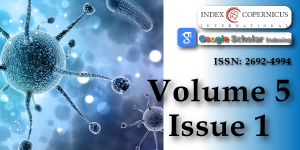COVID-19 New variant and air pollution relationship: how airborne mutagens agent can act on genoma viruses expression: Hypothesis of work
Main Article Content
Abstract
Before actual COVID-19 pandemia coronavirus was not so dangerous like now.
In December 2019 - January 2020 in Wuhan first and then in other places this coronavirus was responsible of a first wave of severe pulmonitis responsible of many deaths.
Wuhan and other region involved first was high level air polluted and industrial area.
New COVID-19 variant in last part of 2020 and in first month of 2021 was responsible of great diffusion of this pandemic disease.
UK, South Africa and brasilian new variant show higher diffusion then the first wave of COVID-19.
Aim of this work is to analyze relationship with air pollution and the possibility that mutagen substantia inside of this microenvironment can produce new variant trough an genetic pressure process.
RNA viruses are normally subjected by natural mutation but some phenomena can contribute to accelerate this process and their airborne – aeresols microenvironment is relevant.
Some air pollutants are recognized as mutagen factors by literature.
Article Details
Copyright (c) 2021 Luisetto M, et al.

This work is licensed under a Creative Commons Attribution 4.0 International License.
Ducatti A, Vargas VMF. Mutagenic activity of airborne particulate matter as an indicative measure of atmospheric pollution. Mutat Res. 2003; 540: 67-77. PubMed: https://pubmed.ncbi.nlm.nih.gov/12972059/
Erdinger L, Dürr M, Höpker KA. Correlations between mutagenic activity of organic extracts of airborne particulate matter, NOx and sulphur dioxide in southern Germany: results of a two-year study. Environ Sci Pollut Res Int. 2005; 12: 10-20. PubMed: https://pubmed.ncbi.nlm.nih.gov/15768736/
Inoue H, Fukunaga A, Okubo S. Mutagenic effects of nitrogen dioxide combined with methylurea and ethylurea in Drosophila melanogaster. Mutat Res. 1981; 88: 281-290. PubMed: https://pubmed.ncbi.nlm.nih.gov/6789194/
Fukino H, Mimura S, Inoue K, Yamane Y. Mutagenicity of airborne particles. Mutat Res. 1982; 102: 237-247. PubMed: https://pubmed.ncbi.nlm.nih.gov/6755233/
Depayras S, Kondakova T, Heipieper HJ, Feuilloley MGJ, Orange N, et al. The Hidden Face of Nitrogen Oxides Species: From Toxic Effects to Potential Cure? Open access peer-reviewed chapter. 2018.
Chang J, Tao J, Xu C, Li Y, Li N, et al. Pollution characteristics of ambient PM2.5–bound benzo[a]pyrene and its cancer risks in Beijing. Sci Total Environ. 209; 654: 735-741. PubMed: https://pubmed.ncbi.nlm.nih.gov/30448664/
Remington KM, Bennett SE, Harris CM, Harris TM, Bebenek K. Highly mutagenic bypass synthesis by T7 RNA polymerase of site-specific benzo[a]pyrene diol epoxide-adducted template DNA. J Biol Chem. 1998; 273: 13170-1316. PubMed: https://pubmed.ncbi.nlm.nih.gov/9582358/
Luisetto M. Deforestation, air pollution and Brasisliant covid-19 variant. Preprint Researchgate. 2021.

